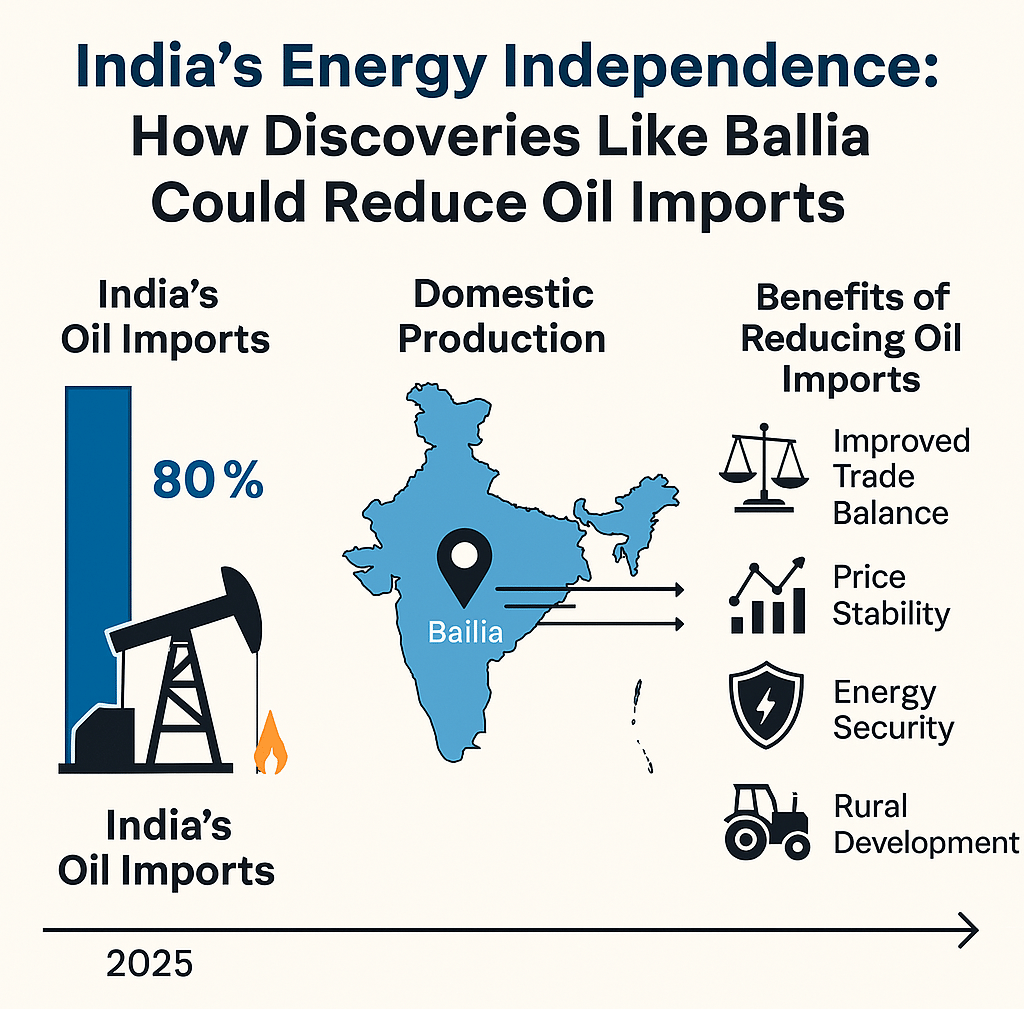India’s Energy Independence: How Discoveries Like Ballia Could Reduce India Oil Import s
4/8/20252 min read


India’s Energy Independence: How Domestic Discoveries Like Ballia Could Reduce Oil Imports (2025)
India is one of the world’s largest importers of crude oil, spending billions every year to meet its energy demands. But with recent domestic discoveries like the crude oil reserves in Ballia, Uttar Pradesh, the conversation is shifting — from import reliance to energy independence.
This blog explores how India can reduce its dependence on imported oil by boosting domestic production and investing in strategic energy assets.
The Current Landscape: India’s Oil Dependency
India imports nearly 85% of its crude oil, primarily from the Middle East.
The high import bill directly impacts the current account deficit and domestic fuel prices.
Geopolitical instability, currency fluctuations, and OPEC decisions increase market volatility.
The Promise of Domestic Discoveries
With ONGC’s recent discovery of crude oil in Ballia after successful exploratory drilling in the Ganga basin, India is seeing fresh hope for self-reliance.
Other regions like:
Assam (Upper Brahmaputra basin)
Rajasthan (Barmer basin)
Western offshore (Mumbai High)
…have contributed to India’s energy production, but more exploration is needed to bridge the gap between demand and domestic supply.
How Ballia’s Discovery Can Impact Energy Strategy
The discovery near Sagarpali village in Ballia has shown promising initial results. If found commercially viable, it could:
Expand into a 300 km oil belt from Ballia to Prayagraj
Create jobs and infrastructure in eastern Uttar Pradesh
Reduce marginal oil import dependency in the next decade
ONGC’s investment signals that India is serious about resource localization and strategic drilling beyond the western offshore zones.
Benefits of Reducing Oil Imports
Improved Trade Balance – Lower oil imports reduce the current account deficit
Stronger Rupee – Less forex outflow for oil imports stabilizes currency
Price Stability – Domestic production cushions against global price shocks
Strategic Reserves – Enables better control over domestic fuel supply
Rural Development – Exploration projects create opportunities in underdeveloped regions
Challenges to Achieving Energy Independence
Exploration success rate is low; not all reserves are commercially viable
High capital costs and long development timelines
Environmental clearance and land acquisition bottlenecks
Technology gaps in deep-sea and shale oil exploration
Need for diversified investments in renewables
The Role of Technology and Policy
The Indian government is promoting Make in India + Atmanirbhar Bharat in energy through:
Open Acreage Licensing Policy (OALP) for faster exploration
Digital oilfield technologies (IoT, AI, seismic mapping)
Strategic Petroleum Reserves (SPR)
Policy support for domestic companies like ONGC, OIL, and Vedanta
Final Thoughts
India’s journey toward energy independence is not about eliminating imports overnight. It’s about gradually increasing domestic capacity, diversifying sources, and leveraging strategic regional discoveries like Ballia.
As India taps into new basins and unlocks hidden reserves, a combination of exploration, innovation, and investment will drive us toward a more secure, self-reliant future.
One Solution is closely tracking India’s energy transition — offering research-backed insights, advisory, and regional analysis for policymakers, investors, and businesses.
Related Blogs:
ONGC’s Role in India’s Energy Sector
Top 10 Natural Resource Discoveries of 2025
India’s Strategic Oil Reserves Explained
About One Solution
Quick Links
Contact Info
One Solution — Your trusted partner for financial success.
📍 F17, Grand Plaza, Paltan Bazar
Guwahati, Kamrup (M), Assam
India, Pin: 781008
📞 9650072280
© 2025 One Solution. All Rights Reserved.
